Changes in the distribution density of locate, Thaisella chocolata (Duclos, 1832) (Gastropoda, Thaididae) as an indicator for predicting their reproductive events
IF 0.8
4区 农林科学
Q3 FISHERIES
Latin American Journal of Aquatic Research
Pub Date : 2023-04-30
DOI:10.3856/vol51-issue2-fulltext-2985
引用次数: 0
Abstract
For a population of locate, Thaisella chocolata, in La Rinconada, Chile, on a grid of 39 stations distributed along three 910 m-long transects at depths of 5 to 18.5 m, Moran and Morisita indices were used to evaluate whether density variations along the depth distribution are related to the stratification of larger sizes at the beginning of their reproductive process. Results indicate that before, during, and after forming reproductive aggregations, there is a T. chocolata increase in density in the shallow stratum (5 to 13 m). This finding is corroborated by the Moran index, which showed a greater autocorrelation in January-May, September-October, and January 2010, and by the Morisita index; thus, it is validated as a potentially easy-to-use indicator for assessing the reproductive process of this species. This index could also alert fishermen to the prevalence of reproductive aggregations in an area and that these aggregations should not be exploited as is currently the case to ensure the reproductive success of this species.作为预测其生殖事件的指标的巧克力塔虫(Duclos,1832)(腹足目,塔虫科)分布密度的变化
对于位于智利拉林科纳达的Thaisella chocolata种群,在沿5至18.5米深度的三条910米长的样带分布的39个站点的网格上,使用Moran和Morisita指数来评估沿深度分布的密度变化是否与繁殖过程开始时较大尺寸的分层有关。结果表明,在形成繁殖聚集之前、期间和之后,浅层(5至13m)中的T.chocolata密度增加。这一发现得到了莫兰指数和莫里西塔指数的证实,莫兰指数在2010年1月至5月、9月至10月和1月表现出更大的自相关性;因此,它被验证为评估该物种繁殖过程的一个潜在的易于使用的指标。该指数还可以提醒渔民注意一个地区繁殖群落的普遍性,不应像目前这样利用这些群落来确保该物种的繁殖成功。
本文章由计算机程序翻译,如有差异,请以英文原文为准。
求助全文
约1分钟内获得全文
求助全文
来源期刊

Latin American Journal of Aquatic Research
FISHERIES-MARINE & FRESHWATER BIOLOGY
CiteScore
1.70
自引率
10.00%
发文量
44
审稿时长
4-8 weeks
期刊介绍:
Latin American Journal of Aquatic Research- LAJAR is the continuation of the journal Investigaciones Marinas (1970-2007) and is published since 2008 by the Escuela de Ciencias del Mar, Facultad de Ciencias del Mar y Geografía of the Pontificia Universidad Católica de Valparaíso. LAJAR is an “Open Access” journal that publishes in English language, original research articles, reviews and short communications on aquatic science, which contain the results of research conducted in aquaculture or in oceanic and coastal marine waters of Latin America.
The following topics are considered: Physical Oceanography, Chemical Oceanography, Marine Biogeochemistry, Marine Pollution and Toxicology, Marine Geology and Geophysics, Biological Oceanography, Fisheries and Aquaculture.
 求助内容:
求助内容: 应助结果提醒方式:
应助结果提醒方式:


